María Teresa Ramírez Figueroa
PhD Student
Universidad Nacional Autónoma de México
Between kitchens and commutes: mobility in domestic work in Mexico
Keywords:
Domestic work, Urban Mobility, Spatial Inequality

Angie has worked for more than twelve years in the domestic work sector in the Metropolitan Area of the Valley of Mexico. She began as a cleaning employee and, over time, moved up to become a cook—a better-paid position that she learned on the job. Her story is like that of many workers who build their day-to-day lives around long labour hours and exhausting commutes, where the cost of getting around is as high as the cost of working.
Currently, Angie works in several homes located in exclusive areas such as Interlomas, Colonia del Valle, and Polanco. Her day starts before dawn, and to reach her destination she must take as many as four different modes of transportation. “If the señora pays me 500 pesos and I spend 100 on taxis, I’m already losing a considerable part of what I earn,” she explains. In some houses, the families cover her transportation cost; in others, she has to pay it herself.
But money isn’t the only cost. Angie has no free time: there is no way to get there quickly. To avoid traffic and save on fares, she leaves home while it is still dark. Her day begins at 4:30 a.m. and ends after 9:00 p.m. “There is no moment of rest. All day long it’s moving: from home to work, from work to home, and then starting over.”
Moving around Mexico City and the State of Mexico is an unequal experience. In the capital, she can walk, take the metro, or use the Metrobús and spend less. In the State, fares are more expensive, routes more complicated, and insecurity a constant risk. “The minimum fare in the State is 12 pesos, whereas in the city it can be half. If you take several modes of transport, you’ve already spent 50 pesos just one way. And if you don’t take a taxi in Bosque Real or Frondoso, you can’t get there. But those taxis charge 50 pesos for a short ride.”
Moreover, some places are built for cars, not for people—and if you don’t have a car, you’re simply excluded. Many of the houses where she works are in gated communities with restricted access, where there are no sidewalks and workers must rely on internal shuttles or taxis to cover short distances. “Employers don’t want to see us walking on their streets. They prefer that we arrive directly at the door, by car or by transport they control,” she says. In these areas, mobility is not only expensive but also regulated in order to render invisible those who work there.
Violence is also part of the commute. Angie has learned to avoid certain routes and to share taxis with other workers to feel safer. “In the city I walk more calmly. In the State, I pay for a taxi. I’ve had incidents: once in transport a man rubbed himself against me. Before, I would make myself small, but one day I got fed up and made a scene. They kicked him out.”
In a city built primarily for cars, other forms of getting around involve restrictions and unequal experiences, such as prolonged waits for units, long lines to board transport, or lengthy journeys that render invisible the commutes of many domestic workers.